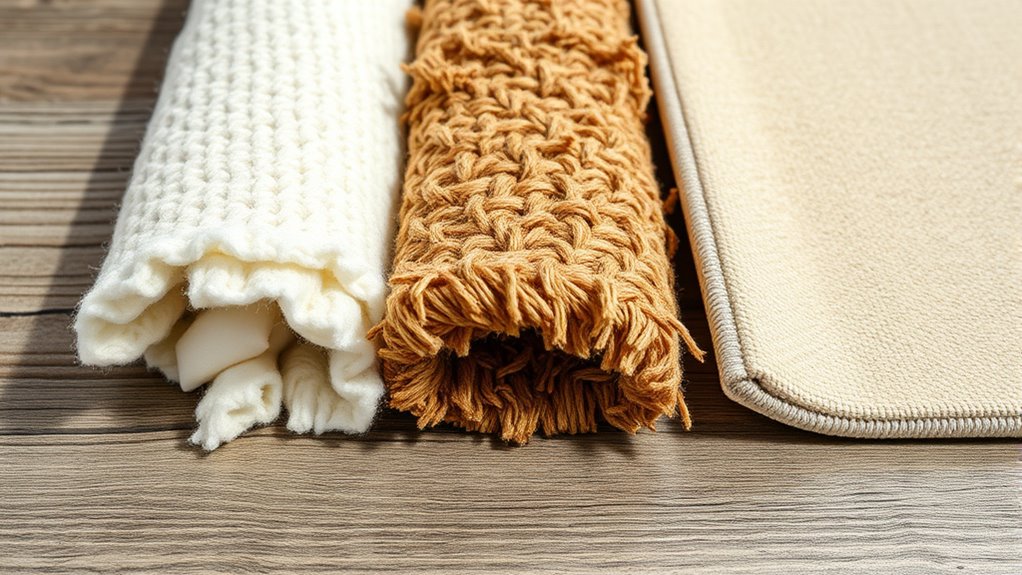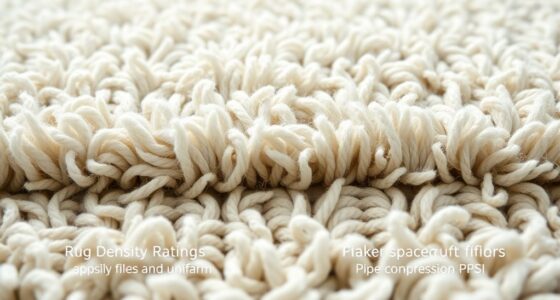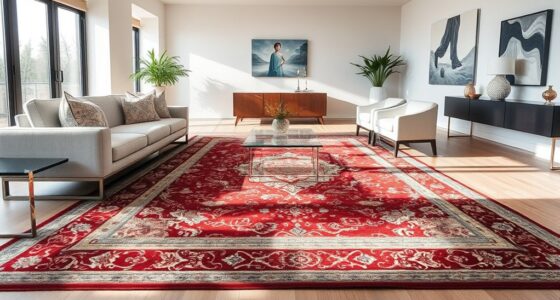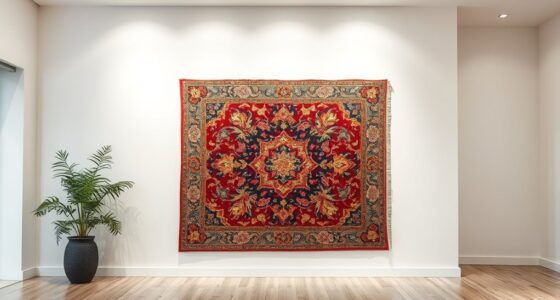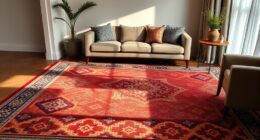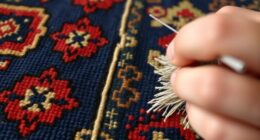When choosing rug backings, you’ll find that cotton offers a smooth, affordable option but has moderate durability and decomposition speed. Jute is eco-friendly with decent wear resistance but can be slippery when wet. Latex provides excellent slip resistance, durability, and waterproof qualities, though it is more costly and slower to biodegrade. Each material serves different needs—exploring further reveals which backing suits your space, safety, and environmental priorities best.
Key Takeaways
- Cotton backing offers a smooth surface with good color retention but is less slip-resistant and biodegrades faster than latex.
- Jute backing is eco-friendly, coarsely woven, and provides moderate durability and slip resistance, suitable for natural aesthetics.
- Latex backing is durable, flexible, waterproof, and provides superior slip resistance but has a slower biodegradation rate and higher energy manufacturing costs.
- Natural fibers like cotton and jute are renewable and biodegradable, supporting sustainability; latex is synthetic and less eco-friendly.
- Cost varies: cotton is most affordable, jute offers a middle range, and latex tends to be the most expensive but most durable.
Material Composition and Manufacturing Processes
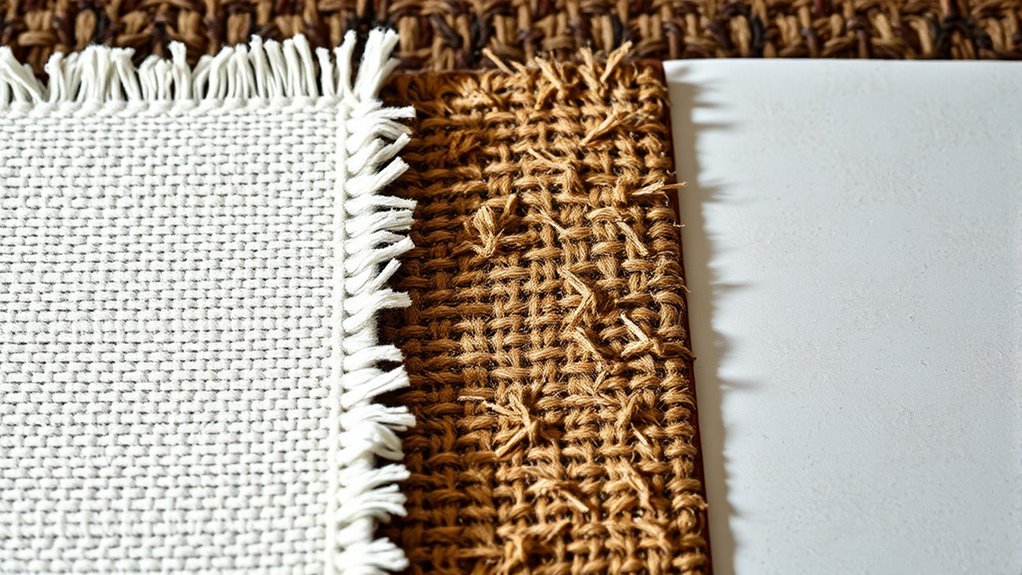
Understanding the material composition and manufacturing processes of rug backings is essential to choosing the right option for your needs. Fiber weave plays a pivotal role here, influencing both the backing’s structure and how well it holds the fibers in place. Cotton backings are woven tightly, offering a smooth surface that supports color retention, helping your rug maintain vibrant hues over time. Jute, on the other hand, is a natural fiber woven in a coarser pattern, providing eco-friendly backing with moderate color retention. Latex backings are produced through a manufacturing process involving vulcanization, creating a flexible, waterproof layer that prevents slipping. Knowing these differences helps you select a rug backing that aligns with your aesthetic preferences and functional needs.
Durability and Wear Resistance
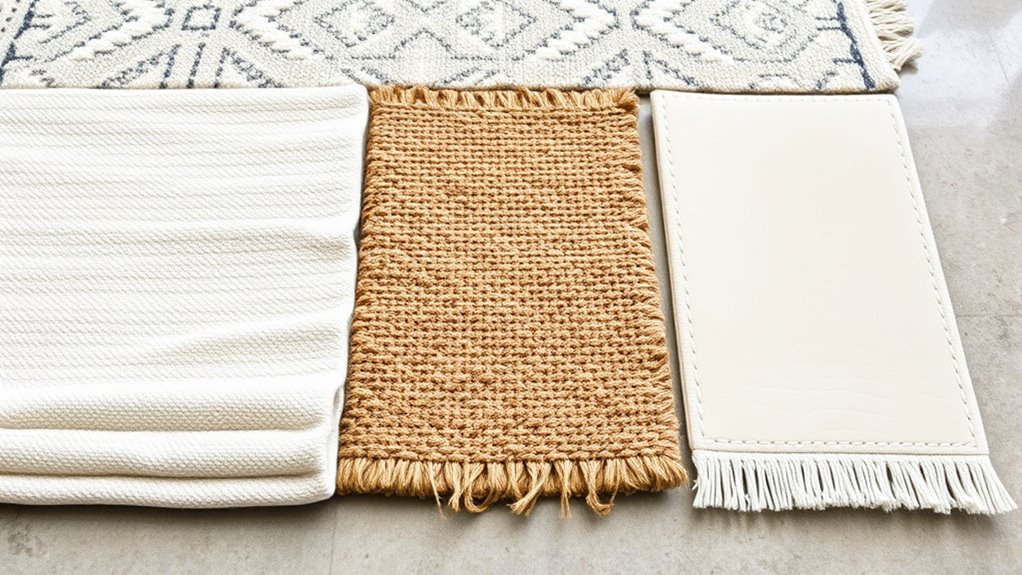
When choosing rug backings, durability and wear resistance are key factors that determine how well the backing will hold up over time. Cotton backings tend to be durable but may show signs of wear with frequent use, especially if exposed to moisture. Jute offers good wear resistance, but its natural fibers can fray or break down over years of heavy foot traffic. Latex backings excel in durability, providing a sturdy foundation that maintains its shape and support. Additionally, each material offers different pattern variety and color options, impacting the overall look of your rug. Latex typically maintains its appearance longer, while cotton and jute may fade or fray sooner, influencing how long they keep their aesthetic appeal. Your choice depends on balancing durability with design preferences. Factors such as material composition and environmental exposure also play crucial roles in how well a backing performs over time. Moreover, understanding the wear resistance of each material can help you select the most suitable backing for high-traffic areas. For instance, Kia Tuning techniques emphasize the importance of selecting components that sustain performance under stress, similar to how choosing the right backing ensures longevity in rugs.
Slip Resistance and Safety Features
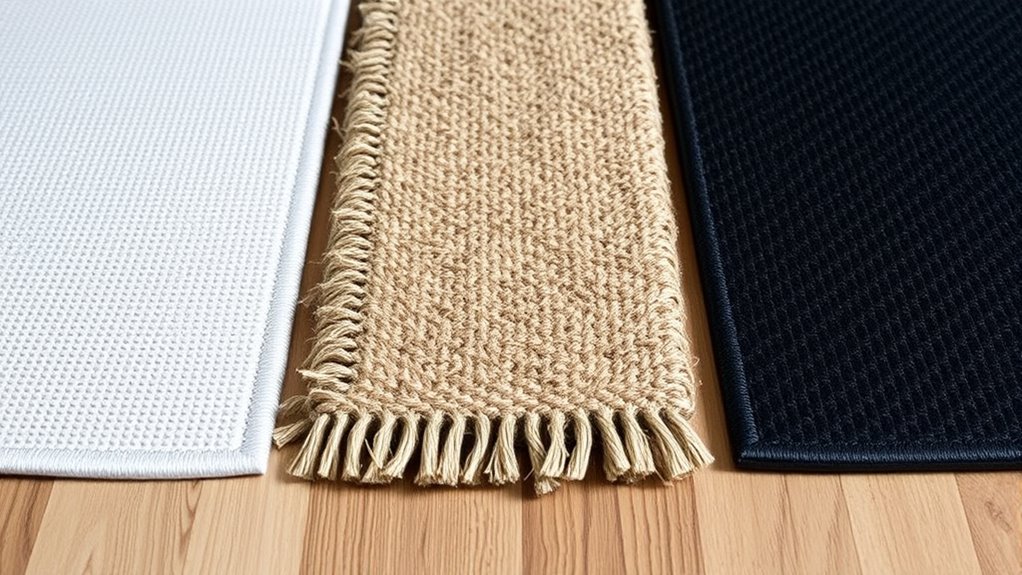
You need to consider slip resistance levels to ensure safety on different flooring surfaces. Choosing the right backing material reduces the risk of accidents and provides better grip. Keep in mind that durability also plays a role in maintaining effective safety features over time. Selecting non-slip materials ensures longevity and consistent safety performance in various environments. Additionally, understanding the specific safety standards for slip resistance can guide you in making the best material choices for your space.
Slip Resistance Levels
Slip resistance levels are essential for ensuring safety on rug backings, as they determine how well a surface can prevent slips and falls. When choosing between cotton, jute, and latex backings, consider their slip resistance properties. Latex backing offers superior grip on smooth surfaces, reducing the risk of accidents. Jute provides moderate slip resistance but can become slick if wet. Cotton backings generally have lower slip resistance unless treated. Additionally, protective styling benefits of certain backing materials can contribute to the longevity and safety of your rug. Beyond safety, slip resistance influences aesthetic appeal and color options; textured latex can add visual interest, while jute’s natural look enhances rustic decor. Cotton backings often come in bright or neutral shades, but their slip resistance is less prominent. Ultimately, balancing slip resistance with aesthetic appeal ensures your rug is both beautiful and safe.
Safety Hazard Reduction
Enhancing safety on rug backings involves implementing features that reduce hazards and prevent accidents. You can improve slip resistance by choosing backings with textured surfaces or adhesive layers, which help keep the rug in place. Aesthetic diversity allows you to select backing options that complement your decor while maintaining safety. For instance, latex backings often offer excellent grip, reducing the risk of slips. Be mindful of allergen concerns, especially if you or your family members have sensitivities; natural materials like jute may pose fewer allergen risks than synthetic options. Additionally, some non-slip rug pads provide better grip and stability, ensuring your rug stays securely in place. Considering material composition can also influence the safety and durability of the rug backing. Using backing materials with enhanced slip resistance can further improve safety by minimizing the potential for slips and falls. Incorporating these safety features ensures your rug remains secure and minimizes trip or fall hazards, creating a safer environment without sacrificing style or comfort.
Backing Material Durability
The durability of rug backing materials directly impacts slip resistance and safety features, ensuring your rug remains secure over time. A durable backing prevents shifting and slipping, reducing hazards. For example, latex offers excellent grip and maintains its safety features longer, even with frequent wear. Jute, while eco-friendly, may weaken faster, decreasing slip resistance over time. Cotton backs provide moderate durability but may lack in slip resistance if not treated properly. Consider these factors: material composition, which influences both longevity and safety performance. Additionally, manufacturing quality plays a crucial role in the overall durability of the backing material.
Maintenance and Cleaning Considerations
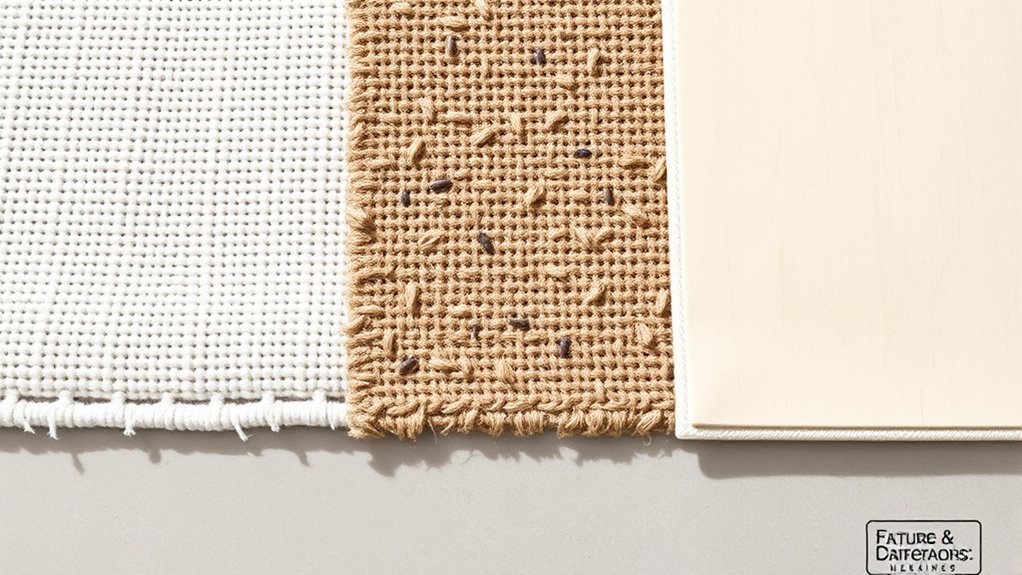
Proper maintenance and cleaning are essential to prolong the life of your rug backing, regardless of its material. To keep your rug in top condition, follow simple cleaning tips like vacuuming regularly to prevent dirt buildup. For stain removal, act quickly—blot spills immediately with a clean cloth, avoiding scrubbing that can damage the backing. For cotton and jute, use gentle cleaning solutions and avoid excessive moisture, which can cause warping or mold. Excessive moisture can also lead to mold growth, compromising your rug’s durability and safety. Latex-backed rugs may require more careful handling; avoid harsh chemicals that can degrade the latex. Always check manufacturer instructions before cleaning. Regular upkeep helps maintain the integrity of the backing, preventing premature wear and ensuring your rug stays looking fresh longer. Additionally, understanding the benefits of heat pump systems can help homeowners make informed choices about energy-efficient upgrades that might impact their overall home maintenance routines. Maintaining proper vacuum cleaner performance can also ensure that dirt and debris are effectively removed without damaging delicate rug backings.
Environmental Impact and Sustainability
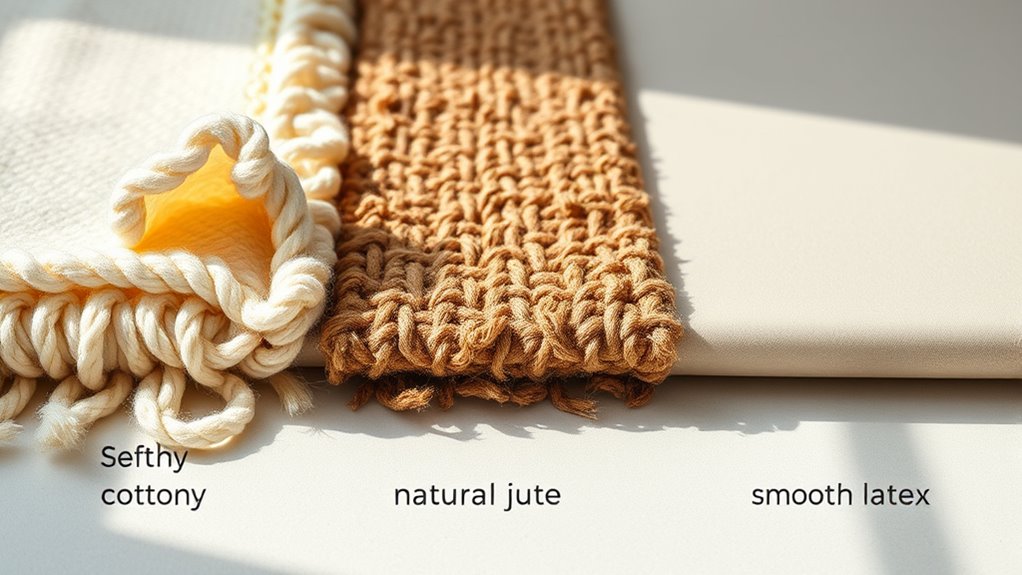
You should consider how different rug backings impact the environment, especially regarding biodegradability and how quickly they decompose. Using renewable resources can reduce your ecological footprint, but manufacturing processes also matter for sustainability. By choosing materials with lower energy footprints, you help minimize environmental harm and promote eco-friendly practices. Implementing cost-effective production methods can further reduce the environmental impact associated with manufacturing. Additionally, selecting backing materials that meet wood stove safety standards ensures that safety is not compromised while prioritizing sustainability. Incorporating biodegradable backing options can also enhance the overall environmental friendliness of your rug choices, supporting sustainable disposal practices and reducing landfill waste. Recognizing the importance of trust issues can also influence how you select environmentally responsible options, ensuring that safety and sustainability go hand in hand.
Biodegradability and Decomposition
Biodegradability and decomposition play crucial roles in determining the environmental impact of rug backings. The biodegradability timeline varies depending on material and conditions, affecting how quickly a backing breaks down. Cotton typically decomposes within a few months to a year in a suitable decomposition environment, making it highly biodegradable. Jute, being natural fiber, also breaks down relatively fast, often within six months to a year, especially in moist, oxygen-rich environments. Latex, however, decomposes much more slowly due to its rubber content, often taking decades and sometimes resisting complete breakdown. Understanding these differences helps you assess the environmental footprint of each backing. Faster biodegradation reduces landfill waste and pollution, emphasizing the importance of selecting materials that decompose efficiently in their respective environments. Promoting biodiversity by choosing biodegradable materials contributes to healthier ecosystems and reduces pollution. Additionally, the biodegradation process can be influenced by factors like temperature, microbial activity, and environmental conditions, which vary across different settings. The presence of microorganisms is essential for accelerating decomposition, especially for natural fibers like cotton and jute.
Renewable Resource Usage
Natural fibers like cotton and jute are renewable resources that offer significant environmental benefits when used as rug backings. Because they regenerate naturally, they reduce long-term environmental impact and support sustainability. Choosing these materials means you’re helping conserve non-renewable resources and lowering carbon footprints. Here’s a comparison:
| Material | Renewable Resource | Environmental Impact |
|---|---|---|
| Cotton | Yes | Moderate water use |
| Jute | Yes | Low pesticide use |
| Latex | No | Synthetic, high energy |
While cotton and jute are sustainable options, latex’s non-renewable nature impacts environmental sustainability. By selecting renewable resource-based backings, you contribute to reducing ecological footprints and promoting eco-friendly practices in rug production. Renewable resources play a crucial role in supporting a sustainable future.
Manufacturing Energy Footprint
Manufacturing a rug involves significant energy consumption, which directly impacts its environmental footprint. The amount of energy used during production influences manufacturing emissions, contributing to air pollution and greenhouse gases. Different backing materials vary in their energy demands; for example, latex typically requires more energy-intensive processes compared to cotton or jute. High energy consumption in manufacturing not only increases carbon emissions but also affects resource sustainability. Reducing energy use, adopting renewable energy sources, and optimizing production methods can minimize this impact. By understanding the energy footprint of each backing material, you can make more eco-conscious choices. Sustainable manufacturing practices help lower overall emissions, supporting environmental health and long-term resource availability.
Cost and Affordability
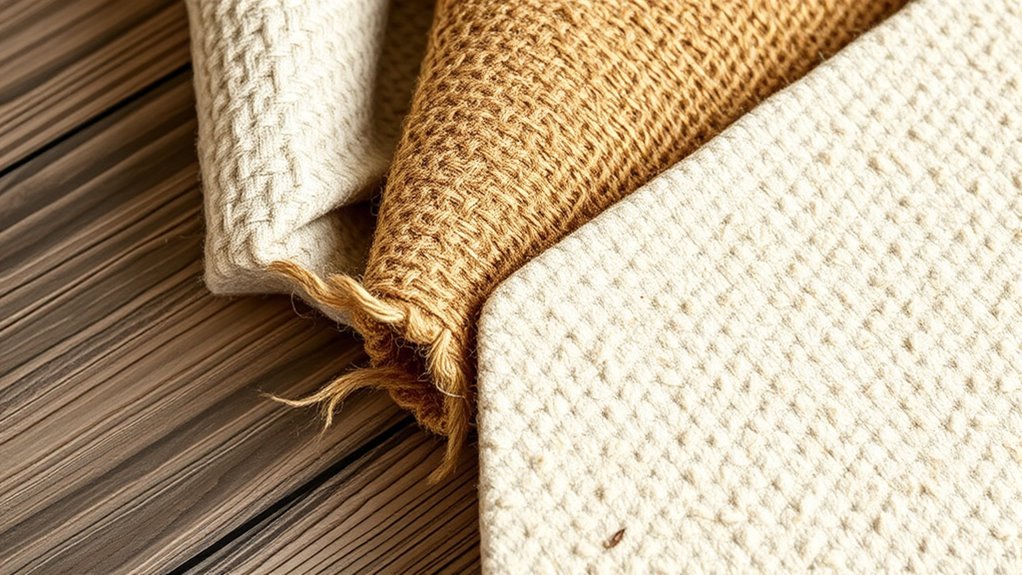
When choosing a rug backing, cost plays a significant role in your decision-making process. You’ll want to weigh budget options and how each backing type compares regarding affordability. Cotton backing tends to be the most budget-friendly, making it ideal for cost-conscious buyers. Jute offers a middle ground with moderate pricing, while latex is often the most expensive but provides durability and longevity. Here’s a quick affordability comparison:
| Backing Type | Cost Range | Durability |
|---|---|---|
| Cotton | Low | Moderate |
| Jute | Moderate | Moderate |
| Latex | High | High |
Evaluating these factors helps you find the best fit for your budget and needs.
Best Uses and Suitable Spaces
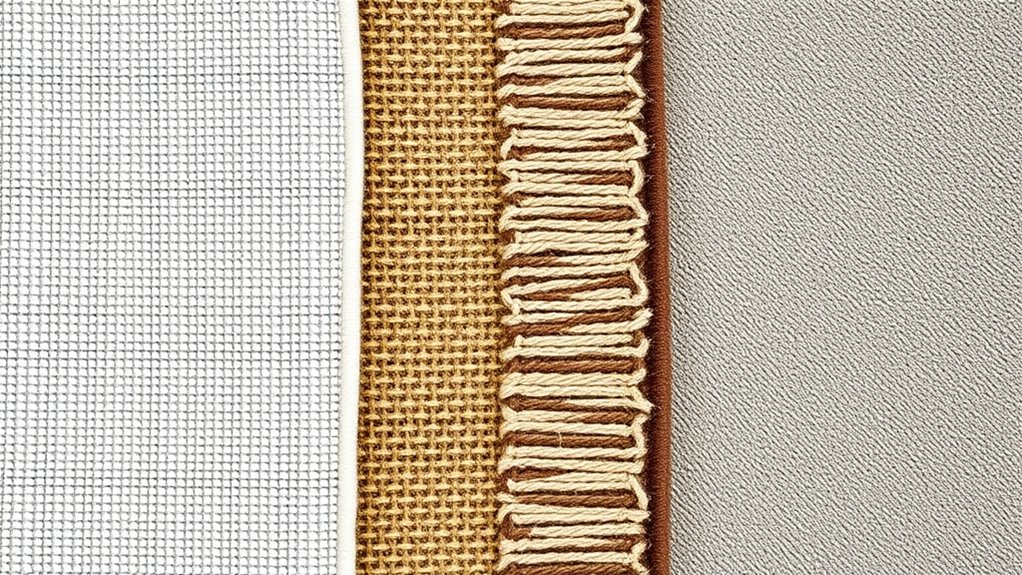
Choosing the right rug backing depends largely on the space and purpose of your rug. For high-traffic areas like hallways or kitchens, latex backing provides durability and slip resistance, ensuring safety and longevity. Jute backing offers an earthy aesthetic appeal, perfect for casual or rustic spaces like living rooms or sunrooms, and it often comes in natural, warm color options. Cotton backing is versatile and soft, suitable for bedrooms or lounge areas where comfort and aesthetic appeal matter most, with various color options to match your decor. Consider the space’s function and style when selecting a backing, as it influences both the visual impact and practicality of your rug. The right choice enhances your space’s overall look while meeting your needs.
Frequently Asked Questions
How Does Each Backing Type Affect Rug Allergy Risks?
When considering rug allergy risks, your allergy sensitivity plays a vital role. The backing material impacts this risk because cotton and jute are natural fibers that usually cause fewer issues, but latex, a synthetic material, can trigger allergies in sensitive individuals. Choosing a rug with a natural backing like cotton or jute may reduce allergy concerns, while latex-backed rugs might pose higher risks if you’re prone to allergic reactions.
Can Rug Backings Be Replaced or Upgraded After Purchase?
You can definitely replace or upgrade rug backings after purchase. Simply start by removing the existing backing carefully, then consider upgrading backing materials like switching from jute to latex for added durability. This process allows you to tailor your rug’s comfort and longevity, making it more suitable for your space. Always consult professional help if needed, ensuring your rug remains secure, stylish, and suited to your specific needs.
Are There Specific Cleaning Products Recommended for Each Backing?
You wonder which cleaning solutions suit your rug backing. For effective backing maintenance, choose cleaning products suited to your rug’s material. Cotton backings respond well to gentle, pH-balanced solutions, while jute needs mild, natural cleaners to prevent damage. Latex backings require careful, water-based cleaning to avoid deterioration. Always check manufacturer recommendations and test any cleaning solution on a small area first to verify compatibility and preserve your rug’s integrity.
How Do Backings Influence Rug Odor Retention Over Time?
Think of your rug’s backing as its invisible armor, quietly influencing odor retention. Cotton backs absorb moisture like a sponge, trapping odors over time, while jute’s porous nature holds onto smells, making odor control tricky. Latex backs form a tight seal, resisting moisture absorption and reducing odor buildup. Your choice impacts how odors linger, so consider a backing that balances moisture management with odor control for lasting freshness.
What Are the Best Storage Practices for Rugs With Different Backings?
When storing rugs, you should consider their backing durability and how to prevent color fading. Keep them in a cool, dry place away from direct sunlight to protect the backing material, whether cotton, jute, or latex. Roll the rug instead of folding it to avoid creases. Use breathable covers to prevent moisture buildup, which can damage the backing and cause odors. Proper storage preserves your rug’s appearance and extends its lifespan.
Conclusion
Choosing the right rug backing is like finding the perfect suit—it should fit your needs perfectly. Cotton offers softness, jute brings natural charm, and latex provides grip and durability. Consider where you’ll place your rug and what matters most—whether it’s longevity, safety, or eco-friendliness. By weighing these options, you’ll find a backing that keeps your space looking sharp and feeling cozy, like a trusted friend you can always count on.
